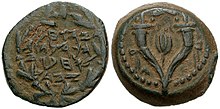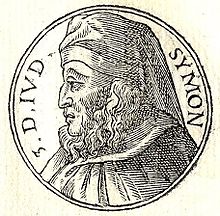Simon (Hasmonean)
Simon (Hebrew שמעון ) Thassi († 135 BC near Jericho ), also Simon Maccabeus (Hebrew maqqaebaet = 'hammer, bat') or Saramel (Hebrew 'prince of God's people'), according to 1 Makk 14, 27-41 EU , was the second son of Mattatias , Jonatan's brother and founder of the Hasmonean dynasty (named after the ancestor Asamon / Hasmon ) in Judea. The meaning of the nickname "Thassi" is unknown.
Life
He took part in the Jewish uprising against the Seleucid Empire led by his brothers Judas Maccabeus and Jonathan . Around the year 163 BC BC he undertook a campaign to Galilee in order to come to the aid of oppressed fellow believers there and to be able to lead them back to Judea ( 1 Makk 5,45-54 EU ).
He supported his brother Jonathan in the Seleucid Wars of Succession and in the conflict with Hellenistic Jews. Antiochus VI. appointed him strategist for the coastal area between Carmel and Egypt . His attempts to free his brother Jonathan, kidnapped by King Diodotus Tryphon , by means of a ransom or by holding hostages failed. Jonathan was born in 143 BC. Murdered BC, but Simon was able to secure his bones and bury them in Modeïn .
High priest and ethnarch
In 142 BC The Seleucid Demetrios II confirmed Simon as high priest and prince after Simon had recognized his sovereignty. He ruled until 135 BC. By a popular assembly of the elders and priests he was in the year 141 BC. Appointed ethnarch (prince of the people) and at the same time appointed high priest.
politics
Around the year 139 BC The new dynasty was recognized by the Roman Senate when an embassy of Simon was in Rome ( 1 Makk 15.15-24 EU ). Around the same time he established diplomatic relations with Sparta ( 1 Makk 14,16-24 EU ).
Probably in 137 BC. He had the Akra of Jerusalem razed after he had driven out the Syrian occupation troops.
Assassination and death
In February 135 he was murdered together with his two eldest sons Mattatias and Judah at the instigation of his son-in-law Ptolemy, son of Abubus, in the fortress Dok near Jericho ( 1 Makk 16.11-24 EU ). His third son, John Hyrcanus, succeeded him in rulership over Judea and in his offices. Simon's grandson Aristobulus I took 104 BC. The title of king.
Historical-religious background

Obverse : double horn of plenty + pomegranate between horns.
Reverse : Five lines in ancient Hebrew script היהודיםיהודה הכהן גדל וחבר היהודיםיהודה הכהן "Jehochanan Hakkohen Haggadol Vecheber Haje-hudim" ( Jehochanan, the high priest, Council of the Judeans ), see Sanhedrin .
During this epoch, the main mainstreams of ancient Judaism appeared historically for the first time:
- Sadducees (conservative, aristocratic families, striving for dominance in social life)
- Pharisees (belief in eternal life limited to believers, strict Torah observance, scripture interpretation and interpretation)
- Essenes ( apocalyptic and messianism , isolation from public life)
Coinage
The Hasmoneans were the first to live in Judea in the 2nd century BC. Minted coins, and it was Simon who prepared this sovereignty. In older works of numismatics and historical research, the first coinage was ascribed to Simon, but more recent research assumes that his son Johannes was able to do so at the earliest.
According to 1 Makk 15.6 EU , Antiochus VII allowed Simon to strike coins in his country:
For many law-abiding Jews, coins were ritually unclean because of the images on them , especially for the Pharisees, for whom even the lay people tried to comply with the priestly purity regulations (see Tahara or Tame ), which in the course of development led to a tightening of the religious regulations. However, this is only one example to illustrate the religious differences between the Sadducees on the one hand, led by the Hasmoneans, and on the other hand the Pharisees and other religious fundamentalist groups within ancient Judaism.
swell
- Flavius Josephus , Jewish War
- Flavius Josephus, Jewish Antiquities
- 1. Book of the Maccabees
literature
- Theodor A. Busink: From Ezekiel to Middot . In: The Temple of Jerusalem from Solomon to Herod . An archaeological-historical study taking into account the Western Semitic temple construction. tape II . Brill Academic Publishers, Leiden 1980, ISBN 978-90-04-06047-0 , pp. 886 ff . ( limited preview in Google Book Search [accessed July 28, 2011]).
- Julius Wellhausen : Israelite and Jewish history . 10th edition. de Gruyter, Berlin 2004, ISBN 978-3-11-017463-2 , p. 258 ff . ( Digitized version or limited preview in Google Book Search [accessed July 28, 2011]).
Web links
- Doris Lambers-Petry: Simon, the Maccabees. In: Michaela Bauks, Klaus Koenen, Stefan Alkier (Eds.): The Scientific Biblical Lexicon on the Internet (WiBiLex), Stuttgart 2006 ff.
- The first book of the Maccabees , Apocrypha , University of Innsbruck
Individual evidence
- ↑ Klaus-Dietrich Schunck: Maccabees / Maccabees books . In: Gerhard Krause, Gerhard Müller (Hrsg.): Theologische Realenzyklopädie . Study edition. Part 2, volume 21 . Walter De Gruyter, Berlin 2000, ISBN 978-3-11-016295-0 , p. 736 ( limited preview in Google Book Search [accessed July 24, 2011]).
-
↑ Charles L. Souvay: Biblical Geography . In: Catholic Encyclopedia . Volume 2, 1907 ( catholic.com [accessed July 21, 2011]).
See also: HJ Wolf: Asaramel . In: International Standard Bible Encyclopedia . 1915 ( biblestudytools.com [accessed July 21, 2011]).
“Wrongly given as a proper name; either some court, or a title of Simon: 'prince of the people of God' ”
"Incorrectly given as a proper name; either a place or a title for Simon: 'Prince of God's People' "
- ↑ Karl-Heinz Vanheiden : From Malachi to Zacharias - 7 ( German ) bible. Today. Retrieved July 20, 2011.
- ^ Q-Z . In: Geoffrey W. Bromiley (Ed.): International Standard Bible Encyclopedia . Volume IV. Eerdmans, William B. Publishing Company, Grand Rapids, Mich., USA 1995, ISBN 978-0-8028-3783-7 (English, limited preview in Google Book Search [accessed July 27, 2011]).
- ↑ Doris Lambers-Petry: Simon, the Maccabees. In: Michaela Bauks, Klaus Koenen, Stefan Alkier (eds.): The scientific biblical dictionary on the Internet (WiBiLex), Stuttgart 2006 ff., Accessed on February 14, 2013.
- ^ Thomas Kelly Cheyne: Encyclopaedia Biblica , Maaziah-Machi . Morang, Toronto 1903 (on Wikisource , English)
-
^ Arthur Bud Chrysler: The Akra. These towers and stepped-stone structure were incorporated into the Akra. (No longer available online.) Biblical Archeology Truth, archived from the original on November 21, 2014 ; accessed on July 27, 2011 (English). Info: The archive link was inserted automatically and has not yet been checked. Please check the original and archive link according to the instructions and then remove this notice.
"The Hasmoneans built their extension to the southern end of the original Temple Mount in 152 BC, before the Akra was razed by Simon in about 137 BC."
“The Hasmoneans built their extension in 152 BC. To the southern end of the original Temple Mount, before the Akra of Simon about 137 BC. Was torn down. "
- ↑ Herbert Donner : From the time of the kings to Alexander the great . In: Hermann Spiekermann, Reinhard Gr. Kratz, Walter Beyerlin (ed.): History of the people of Israel and its neighbors in basic features . The Old Testament German. 4th edition. 4/2, part 2. Vandenhoeck & Ruprecht, Göttingen 2008, ISBN 978-3-525-51680-5 ( limited preview in Google book search [accessed July 19, 2011]).
- ↑ Flavius Josephus : Jewish War ( DjVu ) on Wikisource . Translated by Philipp Kohout. Quirin Haslingers Verlag, Linz 1901, p. 23
- ↑ Ed Snible: Ancient coins of Syria, John Hyrcanus I, ( English ) 2. August 2011. Retrieved on August 2 2011th
- ^ Martin Metzger , Aaron Schart: Outline of the history of Israel ( German ) University of Duisburg-Essen, Institute for Protestant Theology. April 5, 2007. Retrieved July 19, 2011.
- ↑ Anton Grabner-Haider (Ed.): Cultural History of the Bible . Vandenhoeck & Ruprecht, Göttingen 2007, ISBN 978-3-525-57309-9 , pp. 487 ( limited preview in Google Book Search [accessed July 20, 2011]).
- ↑ Ed Snible: Ancient coins of Syria, Simon Maccabaeus ( English ) 2. August 2011. Retrieved on August 2 2011th
- ^ Hans-Peter Kuhnen : Palestine in Greco-Roman times . CH Beck, Munich 1990, ISBN 978-3-406-32876-3 , pp. 86 ( limited preview in Google Book search).
| predecessor | Office | successor |
|---|---|---|
| Zedekiah (597-586) |
Ethnarch of Judea 143-135 BC Chr. |
John Hyrcanus I. |
| personal data | |
|---|---|
| SURNAME | Simon |
| ALTERNATIVE NAMES | Simon Thassi; Simon Maccabeus; Simon the Hasmonean; Shimon; Simon Saramel; Simeon |
| BRIEF DESCRIPTION | Jewish resistance fighter, ethnarch and high priest of Judea, strategist of the Seleucid Empire |
| DATE OF BIRTH | 2nd century BC Chr. |
| PLACE OF BIRTH | Fashionin |
| DATE OF DEATH | 135 BC Chr. |
| Place of death | Dok Fortress, Jericho |

